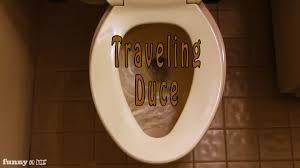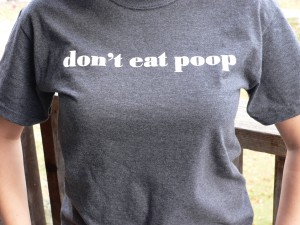Thanks to an alert reader, I have the rebuttal to the Squatty Potty and its magical unicorn turds, via Skeptoid.com. Because we all care about poop.
 The Squatty Potty is an invention by Robert Edwards; its express purpose to to improve the quality and ease of your bowel movements while on the toilet. It has a catchy name and is sold everywhere from Target to Amazon.com. The squatty potty is a stool that is designed to fit around the front of a standard toilet bowl, providing lift to your legs and resulting in a squatting-type position rather than sitting position while moving your bowels.
The Squatty Potty is an invention by Robert Edwards; its express purpose to to improve the quality and ease of your bowel movements while on the toilet. It has a catchy name and is sold everywhere from Target to Amazon.com. The squatty potty is a stool that is designed to fit around the front of a standard toilet bowl, providing lift to your legs and resulting in a squatting-type position rather than sitting position while moving your bowels.
Among the Squatty Potty’s claims are these:
The modern day toilet is convenient, but has one major fault; it requires us to sit. While sitting to do our business may be considered “civilized”, studies show the natural squat position improves our ability to eliminate.
[…]
The puborectalis muscle creates a natural kink to help maintain continence. Squatty Potty relaxes this muscle for fast, easy elimination.
The marketing declares that sitting on the toilet is not as beneficial or effective as squatting. Since this is an obvious naturalistic fallacy, we have the refreshing twist of a new device intended to make one more “natural.” This is common in marketing, where one often sees the equation of “natural=good,” with total disregard for reality. The Squatty Potty is a simple yet interesting device with a catchy name. The marketing is what draws my skeptical eye. They make very specific claims about the research and anatomical benefit—testable claims. Let’s take a close look at the research and find out if the claims are full of it.
The first thing any good skeptic should do when faced with a marketing claim is evaluate the plausibility of the claim. Low plausibility means that claims require more rigorous proof. The Squatty Potty actually scores pretty high on the plausibility scale. The position that the device places you in is a very plausible mechanism for easier stooling.
Raising your legs can be a mechanism to improve your bowel movements. This is irrelevant to the claimed colon-kinking anatomical issue. When you bear down on the toilet, you are performing what’s called a Valsalva maneuver. You are forcing expiration against either a closed glottis, or contracting strongly your thoracic and abdominal muscles increasing intra-abdominal pressure. Similar changes can also occur when a person lifts a heavy weight while holding their breath. Sitting in any squat-type position while bearing down is likely to increase that intra-abdominal pressure, resulting in a more effortless bowel movement. Although this is not the claim in the marketing, the Squatty Potty has a very plausible mechanism to improve the ease of bowel movements.
What about the other claims? Namely that it produces an anatomically improved position and produces a “cleaner colon.” These things are easy to claim and hard to prove. The Squatty Potty is not the first product to claim this benefit. It is a smaller and cheaper version of other squat-position devices, such as the Lilipad and the Nature’s Platform. There are others. Basically they all make the same claims. The Squatty potty claims that it has developed a sweet spot (pun intended) of not too much sitting, not to much squatting.
The website lists several research papers supporting their position:
The first is a Japanese study, “The Influence of Body Position on Defecation in Humans.” It is a small-scale, six-person, uncontrolled study. Sure, I buy it as research, but it is a index study. It limits include tiny non-heterogenous (one male, five female) cohort, with no controls and without blinding. Interestingly, full squat is considered the best, which is not the Squatty Potty position. It doesn’t support the claim that Squatty Potty’s squat is better than a full squat.
The next study has my favorite title of the the group: “Impact of Ethnic Habits on Defecographic Measurements.” (As an aside, I think I need to add “defecographic measurements,” which means “poop X-ray study,” to my medical lexicon… but I digress.) This was a small study that used barium enemas and radiography to evaluate the anorectic opening in defecation.Imaging revealed that the rectal opening was measurable larger in a squatting position. But this study has two major issues. If you use a population that squats to move their bowels and then place them on a first-world toilet bowl, as was done here, you are disrupting their accustomed maneuver. You would need a control group of Europeans to do the same tests to realistically support superior evacuation. Plus moving your bowels is an activity that has deep social and cultural taboos associated with it. Making major changes may cause the participants to rush or change their normal structure. Imaging revealed that the rectal opening was measurable larger in a squatting position. Any of these factors can have a major impact upon on bowel evacuation.
The third research paper posted was “Comparison of Straining During Defecation in Three Positions.” It’s a larger study than the first, but it’s still very small. Researchers used a subjective questionnaire to have subjects rate straining. The findings were similar to the other studies: full squat results in the lowest straining.
Overall the research is flawed and not very compelling. It does have the upside of replications of results. Interestingly, the results do not support the website’s assertion that the Squatty Potty is superior to squatting fully. So I’m not really sure why the website lists this research as scientific evidence for their modified toilet stool.
Based on my reading of the research offered I would say the squatting is the most beneficial for anatomical opening. That is about all the research says. How suboptimal sitting and partial squatting is remains unclear. The study related to straining is too qualitative and small to make that distinction.
Overall, the direct claims The Squatty Potty specifically makes—such as “elevating your feet during elimination is healthier” and “primary (simple) constipation is a consequence of habitual bowel elimination on common toilet seats”—are unsupported by the research they provide.
This is where the Squatty claims are full of it, in my estimation. They cite figures such as these:
“4-10 million Americans have chronic constipation (defined as having a bowel movement less than three times per week), and as many as 63 million people are suffering at any time from occasional constipation.”
The real research is left out of the website’s facts page. Self-reported constipation in the United States and the United Kingdom is more prevalent in women, nonwhites, and those over age 60. And surveys of physician visits for constipation have also confirmed this, finding more visits by women, nonwhites, those with lower incomes, and patients with less than 12 years of education. After adjusting for these factors, it is more common in individuals with little daily physical activity, low income, and poor education.
The prevalence of chronic constipation rises with age, most dramatically in patients 65 years of age or older. In this older age group, approximately 26 percent of men and 34 percent of women complain of constipation. Constipation appears to correlate with decreased caloric intake in the elderly but not with either fluid or fiber intake.
The glaring omission by Squatty Potty here is the fact that constipation correlates with many issues. Yet none of them are position-related. So although the research they offer can suggest that squatting makes bowel movements easier it doesn’t automatically follow that sitting contributes to constipation.
Constipation is a complicated medical issue. There are a myriad of medical conditions, medications, and diseases that cause constipation. Constipation has too many variables to lock it down to a single vague, unproven supposition that your anatomy is interfering with your stooling. Your lower intestines are not a standpipe and fecal consistency is another variable. There is just no credible evidence that sitting is a problem. It may be dangerous to assume that sitting is a problem. Treating simple constipation with a stool may work but it could also be dangerous: you may miss a serious health issue early because you assume that your position is giving you constipation. That is not the only downside for using a toilet stool.
The Squatty Potty marketing gives the false impression that better bowel movements equates with better health. They are not alone; many alternative treatments tend to give the impression that our bowels are trying to kill us. Brian Dunning went over this in Skeptoid episode #83, “The Detoxification Myth.” There is no real evidence that better bowel movements equate with better health. There is no evidence that squatting produces a larger or more complete bowel movement. Even though the position may make an easier bowel movement, that doesn’t equate to bigger or healthier. Anyone who has had to undergo a colonoscopy will tell you that cleaning out your colon is fatiguing and undesirable. Medically speaking, bowel cleansing claims can be dangerous or nonsensical. Your colon is not the center of healthy living, and consequently cleansing is of marginal health benefit.
Overall I would say this about the Squatty Potty: on the positive side it almost certainly enhances your ability to bear down when you go. There is some replicated evidence that squatting does foster ease of going. As for the negatives, there is no evidence that it prevents or treats uncomplicated constipation. There’s no real evidence that anatomic position is a risk factor for constipation, and no real evidence that it is significantly different than other types of toilet squat devices. It leads you to believe that sitting is an impairment to normal bowel movements. That implied problem is not supported by the research and is unlikely, based on uneven distribution of constipation problems.
So why buy a Squatty Potty? I can’t say I think it’s worth it. Truthfully, it looks a little ridiculous, not that that means anything during a bowel movement. It really has no effect on other factors that impact constipation—diet, exercise, age and medical issues. I am uncertain that changing your position is enough of a benefit to help anyone suffering from chronic constipation. I can say that it is not dangerous and it may make it easier for you to bear down or reduce straining if you are constipated. It is just not reasonable to say that it has any significant effect on your overall bowel habits.
On the upside, Squatty Potty is relatively inexpensive, seems safe, and as long as you have a realistic view of the benefit I can see someone using it.









